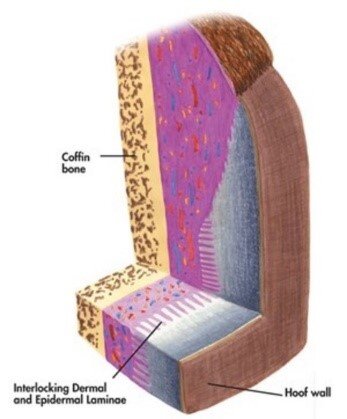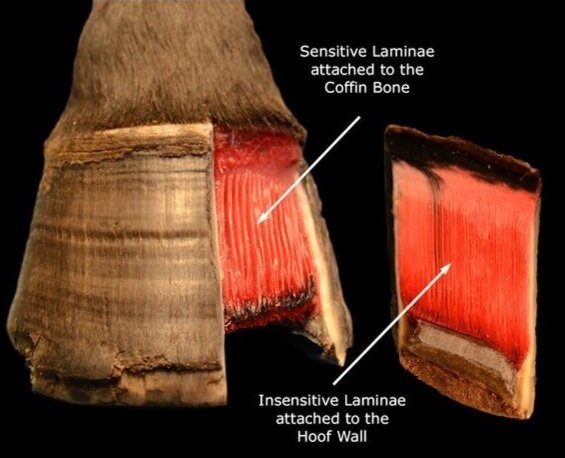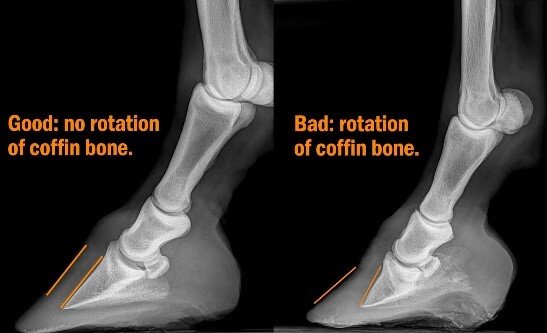What is the lamina?
The foot of a horse is comprised of multiple layers that each play an important role in the structure and function of the foot. The innermost layer is the coffin bone. Next is the lamina, a soft tissue that supports the blood and nerve supply of the foot. The outermost layer is the hoof wall.
There are two layers to the lamina itself. One layer, the ‘sensitive lamina’ attaches to the coffin bone, and the other layer, the ‘insensitive lamina’ attaches to the hoof wall. The two layers of lamina are connected by interlocking finger-like projections – this connection is what keeps the coffin bone secured in place in relation to the hoof wall.
What is laminitis?
The word laminitis means inflammation of the lamina. A common term for laminitis is ‘founder’. When laminitis occurs, those finger-like projections of the two laminar layers become inflamed and their connection is weakened. When severe enough, the connections will begin to separate, and we get downward rotation or sinking of the coffin bone.
Horses bear 60-65% of their weight on their forelimbs, so laminitis most commonly affects the front feet.
What causes laminitis?
The list is long. The 3 main categories with some examples are as follows:
1) Inflammation
· Sepsis/infection
· Grain overload
· Toxicity
2) Endocrine disease
· Equine metabolic disease
· Insulin resistance
· PPID (Equine Cushings)
3) Trauma
· ‘Support limb laminitis’ – horse is bearing more weight on a limb due to injury on the other limb
· Excessive trauma/concussion to the foot
What are the signs of laminitis?
Laminitis causes severe foot pain. Horses who are extremely painful may even want to lay down to relieve pressure on their feet. Other sigs are shifting weight a lot, rocking backwards, sweating and increased heart rate.
How is laminitis diagnosed?
· Digital pulses – there is a large blood vessel that runs up either side of the lower limb. When there is a lot of foot pain, the pressure in that blood vessel will go up and we can feel ‘bounding’ pulses
· Heat – the hoof wall may feel warm to the touch due to the level of inflammation
· Hoof testers – horses with laminitis will be very painful when checked with hoof testers, primarily along their toe
· Radiographs – radiographs are used to diagnose laminitis and determine the severity and prognosis. A measurement is taken to determine the angle between the hoof wall and the coffin bone – this is the degree of rotation.
How is laminitis treated?
Treatment for laminitis is multifaceted. One of the biggest elements of treatment is to identify the cause of the laminitis and eliminate or reduce any predisposing causes. Pain medication along with proper hoof care and support can help to decrease pain. Any treatment should be done under the supervision of a veterinarian.
Post written by Dr. Kristen Wilson
Learn more about Dr. Kristen Wilson here.






